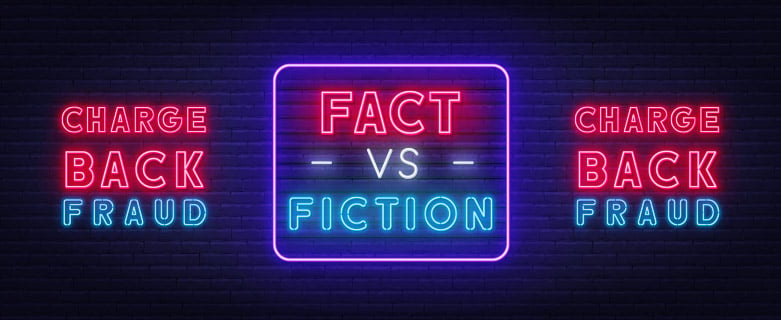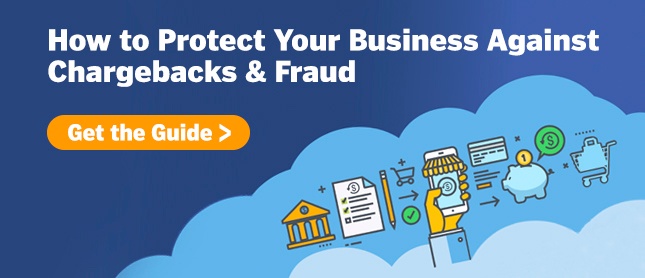
Chargebacks & Fraud: Fact or Fiction?
By Chris Alarie on Jan 13, 2021
Separating fact from fiction with regards to chargebacks can be a difficult endeavor. Rumor, innuendo, and confusion reign supreme. This article will evaluate the truthfulness of some common claims about chargebacks.
Fact or Fiction?
Claim: Most merchant losses from chargebacks are due to criminal fraud.
Verdict: Fiction.
Most chargebacks originate from two general categories: merchant error and fraud. Fraud can be further divided into three sub-categories: true fraud (intentional fraud committed by criminals with stolen or fraudulent payment information), chargeback fraud (intentional consumer fraud), and friendly fraud (unintentional consumer fraud). LexisNexis’s 2016 True Cost of Fraud study tracked these different forms of fraud across different kinds of merchants and consistently found friendly fraud to constitute a larger percentage of fraud losses than either chargeback fraud or true fraud. In fact, among the three, true fraud is the smallest source of fraud.
Claim: The frequency of fraudulent transactions is increasing and is costing merchants more money.
Verdict: Fact.
Numerous financial research institutions have found evidence that fraudulent payment card transactions are becoming both more frequent and more costly for merchants. According to the Federal Trade Commission, cited in a study from Advanced Fraud Solutions, overall card fraud rose over 104% between the first quarter of 2019 and the first quarter of 2020. Fraud is increasing in cost as well as frequency. According to LexisNexis’s 2020 True Cost of Fraud study, every $1 dollar in fraud costs U.S. retailers $3.36 in lost revenue, lost merchandise, fees, and operational cost. This is an increase of 7.3% from the 2019 cost of $3.13.
Moreover, those increases seem to have been exacerbated by the COVID-19 pandemic and related shutdowns. In the aforementioned study, LexisNexis surveyed merchants over a period of time that spanned the immediate pre-shutdown period into the early months of shutdowns. They observed a noticeable uptick in fraud during the period of time they conducted their survey, writing, “Those answering the survey during the shutdown period indicated higher average monthly fraud volumes compared to those taking the survey prior to that timeframe.” Interestingly, they attributed this pandemic-related increase in crime to, among other factors, an increase in “online order/in-store pickup” transactions.
Claim: Sales of physical goods are less of a risk for fraud than digital goods with regards to fraud.
Verdict: Fact.
The aforementioned LexisNexis 2020 study found that “Selling digital goods is riskier than selling physical goods. Detecting fraud in remote channels, especially mobile, is more difficult than in physical stores.”
Claim: The rise of mobile commerce brings new chargeback risks.
Verdict: Fact.
LexisNexis’s 2019 True Cost of Fraud study estimates that mobile fraud attempts more than doubled from 2018 to 2019. And the LexisNexis 2020 study specifically ties the increase in pandemic-related fraud to the increase in mobile commerce, writing, “Mobile transactions volume has increased among e-commerce merchants; this does appear to be related to the COVID 19 shutdown period…. Those conducting international transactions with m-commerce have experienced a significant increase in the percent that cross border transactions account for among all fraud losses.”
Ethoca also highlights an interesting, if not exactly intuitive, connection between mobile commerce and increased chargebacks: the rise of banking apps. Mobile banking apps allow consumers the ability to better track the charges on their accounts. This is beneficial with regards to preventing true fraud but can potentially lead to an increase in friendly fraud due to consumers being confused by unclear billing descriptors. If a consumer sees a legitimate charge that they don’t recognize, they may request a chargeback, not for the purposes of committing fraud but simply due to confusion.
Claim: It is easier than ever for consumers to file chargebacks.
Verdict: Fact.
Ever since the passage of the Dodd–Frank Wall Street Reform and Consumer Protection Act in 2010, it has been significantly easier for consumers to request chargebacks, essentially putting the burden of proof on the merchant rather than the consumer. According to an Ethoca survey, even issuing banks believe that it is too easy for customers to dispute transactions, with 53% of issuer respondents saying so. 72% of merchants in the same survey also agreed with this sentiment.
According to LexisNexis’s 2018 True Cost of Fraud study, 81% of consumers who have filed for chargebacks admit to doing so out of convenience, showing little understanding of the difference between a chargeback and a conventional refund. And consumers who have successfully received a chargeback are nine times more likely to file another one than those who haven’t.
Claim: The best strategy for managing chargebacks is to focus on disputing every single one.
Verdict: Fiction.
Even successfully disputed chargebacks cost merchants in fees and operating costs. In fact, Ethoca estimates that 60% of merchants’ chargeback-related costs come from operating costs compared to lost merchandise and revenue. Moreover, a chargeback ratio that is too high can have massive consequences for a merchant. The best strategy for managing chargebacks isn’t to prepare to dispute them after the fact but rather to try to prevent them before they happen by identifying patterns in buyer behavior and using in-depth analytics tools to monitor your chargeback ratio.
Claim: U.S.-based merchants do not need to worry about fraud because fraud is something that happens in other, high-risk countries.
Verdict: Fiction.
According to the Nilson Report, 48.2% of gross card fraud losses worldwide in 2015 occurred in the United States, for a cost of $7.86 billion. Other recent studies have also shown similar numbers, just below half of all global card fraud. Moreover, approximately 45% of payment card fraud comes from card-not-present (CNP) fraud. Wherever fraud originates, American merchants are clearly the largest targets.
Claim: A successfully disputed chargeback won’t count against a merchant’s chargeback ratio.
Verdict: Fiction.
Unfortunately, card brands only consider the initial chargeback when calculating the chargeback ratio. While it’s obviously beneficial to win as many chargeback disputes as possible, a win does not help a merchant’s chargeback ratio and alleviate the potential risks of superseding the standard 1% limit. Again, preventing chargebacks is more important than winning chargeback disputes. There are valuable tools that can alert merchants to incoming chargebacks and allow them the opportunity to resolve any disputes before they actually become chargebacks.
Claim: Chargebacks and fraud are only problems for small, poorly run businesses.
Verdict: Fiction.
LexisNexis’s 2020 study shows that increases in fraud are actually more acute for midsize and large businesses than for small businesses. While fraud increased from 2019 to 2020 for every sized retailer, the success rate of fraud attempts against midsize and large businesses increased from 43% to 48% in the last year. In LexisNexis’s fraud multiplier calculations, the cost of fraud to small retailers increased by 5.2% from 2019 to 2020 while it increased by 8.2% for midsize and large retailers over the same span of time. Fraud affects every business, regardless of size and prominence. And chargebacks remain a risk for all merchants.
Just the facts, ma'am.
Demystifying chargebacks and fraud is an unceasing process. But the general lessons that can be drawn from these facts and fictions are consistent:
-
Fraud and chargebacks are an ever-increasing problem for merchants.
-
Chargebacks arise from a variety of different kinds of fraud.
-
The only effective protection from the worst consequences of chargebacks is to prevent them as much as possible
A solid chargeback protection plan is essential, but what is a good chargeback protection? What components does it need to have, and how can you tell if they’re working effectively? We’ve got answers for you in this helpful guide, How to Protect Your Business Against Chargebacks & Fraud.



